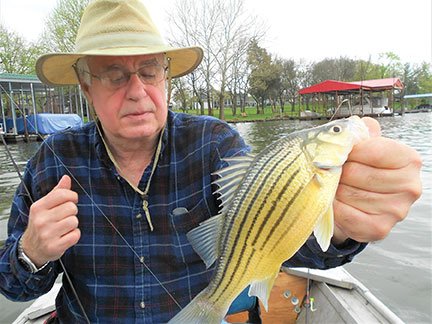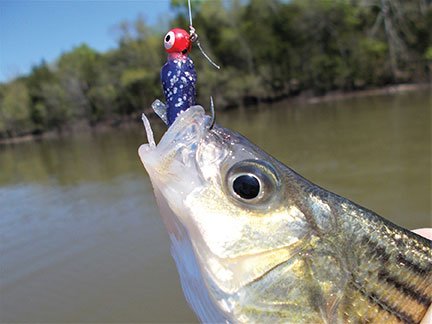For some anglers, yellow bass are a lure-pecking, bait-stealing nuisance. For others, they’re a welcome break from boredom. When nothing else is biting, catching yellow bass beats catching, well, nothing.
Fishing buddy Bob Sherborne and I were casting for crappie on Old Hickory Lake one morning last spring and having no luck, crappie-wise. Sherborne was using tuffies, and Bob’s bobber kept bobbing, but it wasn’t crappie that were mugging his minnows — it was yellow bass.
The gilded little fish with the dark stripes weren’t big, running nine or ten inches, but they hit fast and furious, and they fought hard. Well, hard for their size.
Sherborne was cranking in one after another, while muttering about his declining minnow count. I started flipping my crappie jig in the vicinity of Sherborne’s bouncing bobber, and a yellow bass nailed it almost every cast.
Sherborne switched to a jig to preserve his minnows, and we caught dozens of yellow bass in that one spot. They kept us occupied until the crappie finally woke up on into the morning.
Later that spring I went stripe fishing on the Cumberland River with Lebanon guide Jim Duckworth. We had a productive morning, loading the live-well with big stripe (white bass).
When the stripe run slowed, we counted our catch and found that – having kept only the bigger ones — we needed a couple more for our combined 30-fish limit which Jim wanted for a fish fry.
We drifted down the river, pulled into a creek mouth, and on the first cast we both had hard hits. But instead of stripe, we brought in yellow bass. A school of yellows was mixed in with a school of stripe, and we caught several while waiting for one of their white bass cousins to latch on.
When a good-sized yellow hit, you couldn’t tell the difference in it and a stripe of similar size. It hit hard and fought hard. What’s not to like?
If you’re strictly into big fish, yellow bass are not for you. The Tennessee state-record yellow weighed a mere 2 pounds, 9 ounces. The biggest one I’ve caught weighed perhaps a pound. Most were half that.
Despite their diminutive size and sharp fins — which makes them a literal pain to unhook — yellow bass are delicious to eat. When pan-fried, the thin fillets are crispy, and the meat is firm with a slightly sweetish flavor.
Yellow bass are extremely aggressive. One will sometimes attack a lure almost as large as it is. Sherborne jokes that he’s not sure if the pugnacious little fish has dining or romance on its mind when it latches onto the plug.
In the spring and fall, yellow bass can be found in large schools, splatting and splashing on the surface as they chase minnows. They congregate in creek mouths, shallow coves and around docks.
When you find a school of feeding yellow bass you can catch one just about every cast, on any type of bait or lure.
Considering the price of minnows, crappie fishermen aren’t thrilled to encounter a school of yellow bass. They can empty a minnow bucket in no time. Same with worms.
Bluegill and crappie anglers sometimes move to another spot when yellow bass move in.
Yellows can also be a pest for lure fishermen. They are so aggressive they will shred a plastic crappie jig, and un-hooking them from a treble-hook bass plug takes patience and caution. Their mouths are small, their jaws are tough, and their dorsal and pectoral fins have sharp barbs that are as painfully prickly as a catfish’s.
But, I never complain about catching fish – any fish – so I don’t gripe about yellow bass. The scrappy little half-pints can liven up an otherwise dull day.
The way I see it, catching a little fish beats catching no fish.
Sometimes when yellow bass are biting and nothing else is, I toss some of the bigger ones in the live-well for the platter.
Eating a little fish beats – well, you know.
You won’t hear fishermen bragging about their catch of yellow bass, or see your buddy’s picture in the paper holding one and grinning. You probably will never see a 10-incher mounted and hanging on a den wall.
Yellow bass may not be the fish of choice, but sometimes fishermen can’t be choosy.




